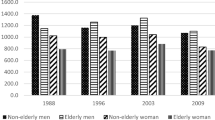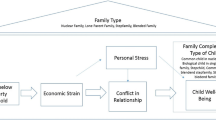Abstract
This study examines differences in expenditure patterns between divorced single-mother families and two-parent families in South Korea. Data were obtained from 353 families living in Seoul: 51 divorced single-mother families and 302 two-parent families.
Expenditure patterns are considered as the budget share of each given expenditure in addition to the elasticities of those expenditures. The budget shares for food consumed at home, shelter, and education of divorced single-mother families are substantially higher than those of two-parent families. Income elasticities of expenditures of divorced single-mother families for education and for apparel and shoes are more elastic than for two-parent families, while food eaten at home and entertainment are less elastic. The results of this study indicate that there are significant differences in the patterns of consumption expenditures between divorced single-mother families and two-parent families.
Similar content being viewed by others
References
Abdel-Ghany, M., & Foster, A. (1982). Impact of income and wife's education on family consumption expenditures. Journal of Consumer Studies and Home Economics, 6, 21–28.
Bellante, D., & Foster, A. (1984). Working wives and expenditure on services. Journal of Consumer Research, 11, 700–707.
Dardis, R., Derrick, F., & Lehfeld, A. (1981). Clothing demand in the United States: A cross-sectional analysis. Home Economics Research Journal, 10, 212–222.
Davis, J. (1945). Standards and content of living. American Economic Review, 35, 1–15.
DeWeese, G. (1989). Female-headed households: Impact of family structure in household expenditures for clothing. In M. Carsky (Ed.), Proceedings of the 35th Annual Conference of the American Council on Consumer Interests (pp. 210–215). Columbia, MO: American Council on Consumer Interests.
DongA Annual Report (1996). Statistical abstract of Korea: 1995. Seoul: Korea National Statistics Office.
Douglas, E. (1980). Changing patterns of consumption expenditures. In N. M. Ackerman (Ed.), Proceedings of the 26th Annual Conference of the American Council on Consumer Interests (pp. 41–47). Columbia, MO: American Council on Consumer Interests.
Douglas, S. (1976). Cross-national comparisons and consumer stereotypes: A case study of working and non-working wives in the U.S. and France. Journal of Consumer Research, 3, 12–20.
Garfinkel, I., & McLanahan, S. (1986). Single mothers and their children. Washington, DC: Urban Institute Press.
Hefferan, C. (1987). Consumer spending and saving: The outlook for 1988 (Annual Agricultural Outlook Conference, Outlook '88, Session # 25, United State Department of Agriculture). Washington, DC: U.S. Government Printing Office.
Horton, S., & Hafstrom, J. (1985). Income elasticities for selected consumption categories: Consumption of single female-headed and two-parent families. Home Economics Research Journal, 13, 292–303.
Hoyt, E. (1959). A new approach to standards of living. Journal of Home Economics, 51, 83–86.
Joung, S. H. (1992). Market substitutes for housework: Variations in use. Ph.D. diss., Urbana: University of Illinois at Urbana-Champaign.
Korean National Statistical Office. (1991). Statistical abstract of Korea: 1990. Seoul: Author.
Korean National Statistical Office. (1994). Statistical abstract of Korea: 1993. Seoul: Author.
Korea Women's Enlightenment Institute. (1988). A study on low-income female-headed families (Reports, Series 200-2). Seoul: Author.
Lazear, E., & Michael, R. (1988). Allocation of income within the household. Chicago: University of Chicago Press.
Lino, M. (1990). Factors affecting expenditures of single-parent households. Home Economics Research Journal, 18, 191–201.
Magrabi, F. M., Chung, T. S., Cha, S. S., & Yang, S. J. (1991). The economics of household consumption. New York: Praeger.
Oh, T. (1986). Data analysis methods in social science. Seoul: NaNam Publishing Co.
Schiller, B. (1989). The economics of poverty and discrimination (5th ed.). Englewood Cliffs, NJ: Prentice-Hall.
Schwenk, F. (1989). Households with expenditures for housekeeping services, including child care. Family Economics Review, 2(4), 15–20.
U.S. Bureau of the Census. (1991). Statistical abstract of the United States, 1990 (110th ed.). Washington, DC: U.S. Government Printing Office.
Wagner, J., & Lucero-Campins, L. (1988). Social class: A multivariate analysis of its effect on expenditures for household services. Journal of Consumer Studies and Home Economics, 12, 373–387.
Yang, S. J. (1991). A study on changes in the patterns of consumption expenditures in urban households. Korean Consumption Living Review, 8, 54–67.
Author information
Authors and Affiliations
Rights and permissions
About this article
Cite this article
Moon, SJ., Joung, SH. Expenditure Patterns of Divorced Single-Mother Families and Two-Parent Families in South Korea. Journal of Family and Economic Issues 18, 147–162 (1997). https://doi.org/10.1023/A:1024972223283
Issue Date:
DOI: https://doi.org/10.1023/A:1024972223283




